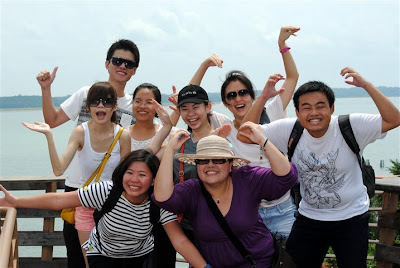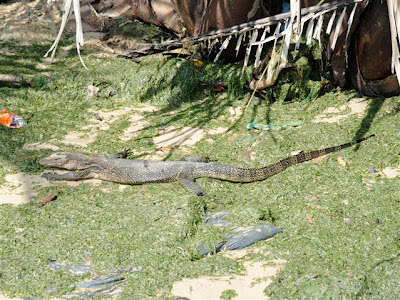After two months of inactivity, I am back blogging on my previous nature trips! Over the 2nd Saturdays of the past three months, I have been out guiding at Chek Jawa with the Naked Hermit Crabs.
And of course not forgetting the lovely families from the September group- from which we had the honour of having Dr Tan Swee Hee and his family with us.
My student councillors from Dunman High School were present on all three trips to both observe and co-guide together with us as part of our council's EXCEL programme which hopes to expose students to real issues, and real efforts to address them by real people.
In case you are wondering why they look so amused in this photo, that was because I tried to take a photo with my lens cap on. =_=
There were lots of awesome sightings throughout the three months worth of guided walks such as this flowering palm.
The flowers of the palm tree attracted many bees and I simply love this colourful photo of the flowers and the bees.
As Chek Jawa used to be inhabited with many villagers living by the sea, many fruit trees such as durian trees were planted. Thus once in a while, we do see fallen durians such as this!
The Jejawi Tower is named after the Malayan Banyan (Ficus microcarpa) growing nearby that was as tall as the tower. The Malayan Banyan is a fig tree.
As fig trees produce figs very regularly, they are able to provide regular food supplies for all kinds of animals such as birds and monkeys, unlike other forest trees that fruit perhaps once a year or even once every few years.
On the boardwalk, lots of interesting information nuggets about marine life were shared! Here's Jialing engaging the crowd with "sensational" stories about how barnacles mate.
Last month, we were very fortunate to witness this Great-billed Heron (Ardea sumatrana) flying into the mangroves to perch and rest. Do you know that it is the tallest bird in Singapore?
It is always heartening to see new growth such as the seedlings growing out from the fallen fruits of the Nipah Palm.
A special plant that I recently took notice of would be this Great Morinda (Morinda citrifolia). Also called noni, the fruit has a strong smell and bitter taste, and is consumed either cooked or raw.
There are commercial products such as effervescent drinks as the juice is believed to be beneficial to health. I happen to see this at a supermarket and I bought to try it!
Surprise surprise! While we were walking away from the Morinda plant, I saw this stationary Painted bronzeback (Dendrelaphis pictus)! It was a special treat for all of us to observe a snake who was not shy of us.
Only seen during the October trip, the Delek air (Memecylon edule) was blooming with bright purple flowers!
The scary looking weaver ants are all at hard work to build their homes by bringing together many leaves of the plant.
Beneath the leaves of the sea hibiscus plants are many of these brightly coloured nymphs of the cotton stainer bugs.
One of the favourite shots would be this bluish dragonfly with bright orangey eyes perching itself on the root of the mangrove. It was rather still, allowing me to take a photo.
That's not all! You can find more animals living on and among the roots of the mangroves such as this mudskipper!
This hermit crab clinging onto the root was the perfect individual for me to share about the history and reason why we are known as Naked Hermit Crabs.
Chek Jawa is one of the rare places where we can spot many small fiddler crabs in different bright colours.
Here's a collage of some of them in different colours and patterns.
What can we find below this stretch of the boardwalk that drew so many of our attention?
Lots of fiddler crabs! They are found in great number when the tide recedes out! The male crabs are all happily waving their large claws at the ladies. :)
Larger crabs such as this one with pretty red claws can also be found, but they are more common at the back mangroves.
Lots of algae line the shore where the mangroves and the intertidal area meet. This Little Heron (Butroides striatus) was seen having a tug of war with some of the algae. Quite a funny sight!
Is there anything to see on a high tide from the boardwalk? Yes! Here's my student Yu Lian sharing with our group.
Many schools of mullets were seen swimming around the shore as the tide came in.
Yesterday, we were very fortunate to encounter the jellyfish season where lots of these pinkish jellyfish were seen swimming in the waters.
Larger animals such as this monitor lizard can also be sighted if you look out for them. This fellow seems to be enjoying the bask under the sun.
A lovely dog met us during the October trip and it was friendly to allow us to touch it.
The wild boars would occasionally make its visit to say hi to us at various part of Chek Jawa.
All too soon, the guided walk would end off with guest book drawing sessions. The kids always do a great job depicting the beauty of Chek Jawa through their perspectives.
Here's my students Raphael, Songshan and Jinjing with all the drawing and colouring.
And we have Songshan (again), Yu Lian, Ruo Ting and Ming Quan with their favourite kid showcasing his masterpiece.
If you have time, do read the reflections written by Raphael Lee and Jinjing about their experience in Chek Jawa with Naked Hermit Crabs.
It has been an awesome three months worth of trips sharing Chek Jawa with my students and the public. Looking forward to return again soon!
The photos for our Nov trip can be found here:
Oct trip: http://www.flickr.com/photos/Sept trip: http://www.flickr.com/photos/








































No comments:
Post a Comment